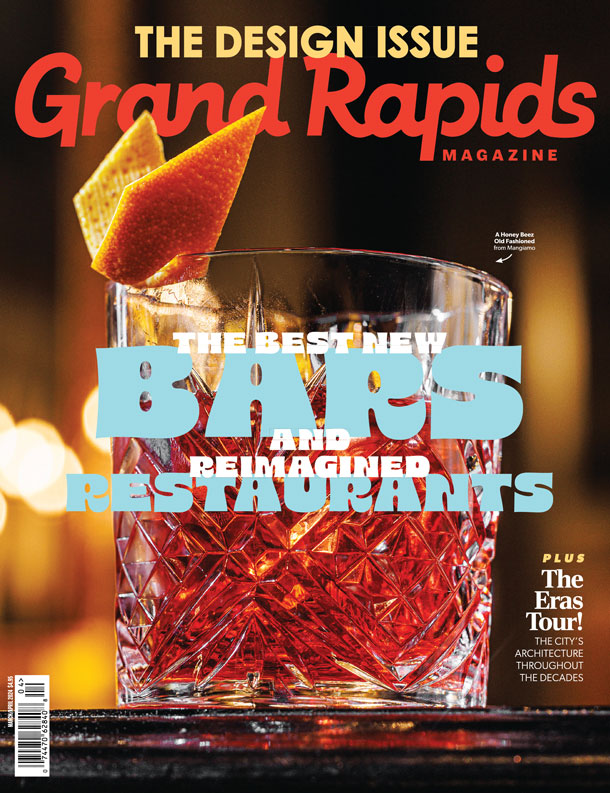
Maybe it’s the voices of the first church members of 1875 whispering guidance. Maybe it’s the spirit of the historic church itself speaking. Whatever the source, Grand Rapids’ historic Third Reformed Church, 1001 Hermitage St. SE, seems to be leading the way in its own restoration process, as current owner, Carol Moore, listens — and works.
“The building tells you what to do, and it’s just kind of fun to take its lead,” said Moore, who lived just blocks from the church for over 40 years. After passing the building daily for decades, Moore saw the 19th-century church becoming dilapidated after its last use as a Latino church.
“I’ve been walking by and driving by for the 41 years I’ve lived here. … For the last decade or more, it’s been going down, down, down. I just thought, ‘Isn’t anybody going to take care of this building?’ It went up for sale, and I made an offer,” said Moore, who purchased the church in October 2017.
That offer was $100,000, which Moore paid out of pocket. Her projections for completion of the renovations are about $5 million, for which she’s relying partly on donations, and five years’ time.
Moore’s love of historic buildings grew during her early life in Savannah, Georgia, and is now the impetus behind her hands-on, all-in approach to restoring historic buildings in Grand Rapids. On her list of eight restored buildings thus far is the Wealthy Theatre, joined most recently by the Third Reformed Church, listed in the National Register of Historic Places and currently in the process of being returned to its glory days — but with a twist. After nearly two centuries as a place of worship, the building will be given a new life as a community arts hub.
“This is a restoration for an adaptive reuse of this beautiful historic building. It will focus on the arts, whether they are performing arts, literary arts, visual arts. … It’s a resource within a neighborhood that draws from all the surrounding area. We value diversity and inclusion,” Moore said.
Among those she has met with about the future life of the building is Jennifer Williams, principal of nearby Congress Elementary School. According to Moore, the two had a long meeting about future collaboration with the goal of strengthening the neighborhood through its students’ involvement with the arts.
Keeping her focus on invigorating the neighborhood community, Moore rolls up her sleeves and gets into the process herself, engaging in projects like removing oak trim from the interior that she stripped and refinished at home. Noting she leaves the carpentry to those with the proper acumen, her hands-on approach to historic preservation includes having sanded floors, finished woodwork and painting.
While donations totaling about $40,000 have come in, as well as donated resources from area businesses, the project has brought challenges as well as generosity and enthusiasm. One of those challenges came by way of high voltage wires a mere 4 feet from the west side of the building. Ironically, the church had been built before electricity, yet with the wiring so close to the building’s exterior wall, for decades, it was unsafe to do repairs or painting there, where scaffolding couldn’t be raised.
“There was a lot that happened to get (the power company) to move those wires. … It took a lot of persuading, but they came through. That opened up a whole opportunity for us to work on that side of the building,” Moore said.
The building’s history also reflects the changing life of the city. First built to serve the early Dutch population, the church was sold after the congregation relocated in 1968. The building was then home to a Black congregation before a Latino congregation worshipped there. During its lifetime, the church has celebrated change and diversity, something it will continue to be part of in bringing together the community to celebrate the arts together. That time in its future is much anticipated, as are various parts of the restoration itself.
The aesthetic value of the building is what many are excited about, such as seeing the restoration of the church’s antique stained glass windows, yet the reality is it’s the infrastructure that must first continue to be made sound.
Having purchased the building in autumn, the first step in this ongoing project was taking measures to prevent further damage from water and snow. Since then, the steeple and cupola have been restored, and the church continues to lead the way, revealing as time and effort continue, what needs to be done next. Moore’s vision is to keep the building as close to original as possible, down to details such as original paint colors that can be identified.
Attached to the church is a parsonage, a smaller venue that Moore identifies as having wonderful potential itself, saying it would be ideal for smaller gatherings.
With the dream of a grand re-opening still a few years in the future, Moore is undecided about the performance that will lead off that day, but what’s certain is it will be a celebration of the arts, and that the church, with noteworthy acoustics, provides an optimal venue for musical performances and dance.
“Last October, we had an open house. About 300 people showed up to tour the building,” Moore said. “Members of the Grand Rapids Symphony played, we had a dancer who danced. It was so exciting to see people so happy to perform in this building. … There were so many smiling faces. That is what this building is meant for now. This is the future of this building.”








Facebook Comments